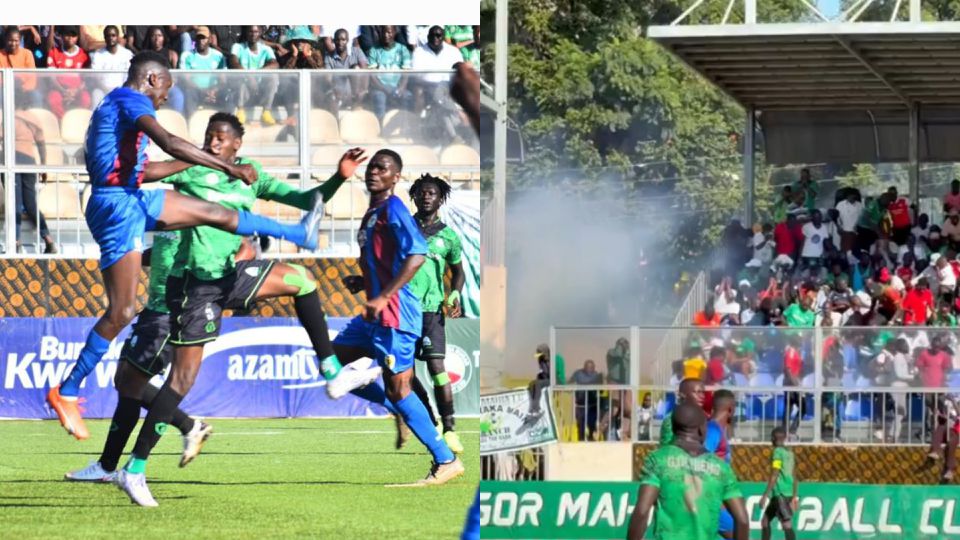Few things send a deeper chill through the veins of Kenyan sport than the moment when the beautiful game’s celebration is shattered by violence. On April 27, 2025, that chill became painfully real outside Dandora Stadium. The journalist assault at Dandora Stadium forced both football and media communities to reckon with troubling questions about safety, accountability, and the fragile contract between those who play, those who watch, and those who bear witness through their words and photographs.
The agony before kickoff
Chris Omollo, a photojournalist for Nation Media Group, arrived with colleagues to cover the highly anticipated Gor Mahia versus Mara Sugar match, an FKF Premier League clash expected to bring Nairobi football fans to their feet. Instead of the usual surge of pre-game adrenaline, panic descended outside the stadium gates. Omollo, carrying his heavy photographic equipment, identified himself as a journalist and awaited access—standard procedure at any major match. In a shocking twist, a police officer assigned to gate security struck him on the back of the head, causing him to collapse. In that instant, routine became chaos, and a moment meant for sport turned into an emergency.
The reactions of nearby officers did little to assure colleagues or bystanders. Instead of immediate assistance, police blocked Omollo’s team from rendering aid, some even calling for their removal. Only after intervention from a senior officer was help finally permitted, while an ambulance was arranged. For Omollo, the result was an ambulance ride to Aga Khan Hospital, where he remained hospitalized, fighting for his life. Chris Omollo’s case ignited not only outrage but a heart-wrenching sense that the price of telling sporting stories in Kenya has become far too high.
| CASINO | BONUS | INFO | RATING | |
|---|---|---|---|---|
|
bonus
Refer friends, win cash prizes!
|
info
BK 0000672 PG 0000412 Mobile-friendly |
|||
|
bonus
Register for up to 31,400 KSH bonus on deposits!
See 12 Bonuses
|
info
No. ALSI-112310012-F15 Unique selection of slots & games |
|||
|
bonus
100% bonus up to 15000 KSH on first deposit!
See 9 Bonuses
|
info
BK 0000698 PG 0000424 Excellent customer support, large selection of slot games, and multilingual website. |
|||
|
bonus
Refer a friend and claim KSH 250
See 4 Bonuses
|
info
BK 0000739 PG 0000468 BCLB license, registration bonus, variety of casino games |
How a sport’s celebration unraveled
Violence before Kenyan football matches is not new, but this incident drew swift, public condemnation from all corners. Omollo’s colleagues recalled presenting their official badges and waiting peacefully at a crowded entry point where stewards were controlling access. The attack, they insist, was utterly unprovoked. Their attempts to help were blocked by officers worried about the swelling, restless crowd. Even after the senior officer’s decision to let them render aid, the sense of confusion and dread lingered.
Evidence of frayed relationships between security forces and Kenyan media has grown in recent years. Journalists—photographers and writers alike—have increasingly faced harassment, threats, and even violence. The attack on Omollo sent immediate ripples through the sporting and reporting communities, raising fears that journalists might soon avoid covering major games altogether if nothing changes.
Immediate reactions and calls for justice
The power of football in Kenya is indisputable, but so is the power of the written—and photographed—word. The incident at Dandora Stadium prompted a chorus of condemnation from the Football Kenya Federation (FKF) and the Sports Journalists Association of Kenya (SJAK), organizations often on different sides of the sporting fence but, in this case, unified.
FKF president Hussein Mohammed did not mince words. Describing Omollo as a close friend and colleague, he called the violence “deeply concerning” and a betrayal of what football should represent—a safe, joyous celebration. The FKF released an official statement, vowing to work closely with the National Police Service, the clubs Gor Mahia and Mara Sugar, and stadium management to conduct a thorough investigation. Their promise: hold those responsible accountable and overhaul security protocols so that what happened at Dandora never happens again.
As one FKF statement stressed, “The media and fans are integral to the football ecosystem, and their safety is a top priority. FKF is fully committed to ensuring that all individuals can attend and cover football matches in a secure environment, free from harm.” This was not just rhetoric; FKF leaders visited Omollo in hospital, giving weight and a human face to their words.
SJAK’s stand—no press, no football
SJAK, representing the country’s sports journalists, took an even more combative stance. In a strongly worded letter to FKF, Secretary-General Moses Wakhisi emphasized that this was not an isolated event. Rather, it was a disturbing addition to a pattern of aggression against journalists covering Kenyan football. He wrote, “The safety of our members must be guaranteed at all times, particularly in the course of their professional duties. The actions of the police officer involved in this assault are unacceptable and cannot go unpunished.”
SJAK went further, threatening to boycott all FKF-related activities unless concrete and immediate action was taken. President James Waindi echoed this, promising a total blackout if Omollo’s attacker was not swiftly brought to justice. It was a bold move—but one that resonated with journalists and fans alike, many of whom believe football’s growth relies as much on those who tell its stories as those who score its goals.
The wider context—violence, mistrust, and football’s crossroads
For some, the Dandora Stadium incident is the latest manifestation of a deeper malaise. Dandora itself has earned a reputation as a challenging, sometimes volatile venue. There have been previous reports of journalists and fans subjected to harassment, even after showing their credentials. On the same day as Omollo’s assault, police also teargassed fans outside the stadium following separate altercations, inadvertently forcing players off the field as gas seeped inside. The match paused, but the sense of insecurity lingered.
These events follow a string of violent flashpoints at matches across Kenya—from fan unrest at Machakos Stadium to high-profile confrontations at Jomo Kenyatta Stadium. The FKF has faced mounting pressure to ensure that matchday security covers not only athletes and spectators but also the vital corps of journalists whose work connects games to the wider world.
As football’s popularity grows, so does the scrutiny over how matches are managed. The Rapid Deployment Unit, often responsible for stadium security, now finds itself at the center of uncomfortable questions about training, crowd control, and respect for professional rights. And for the media—as both witness and storyteller—the risk calculus at each game is changing rapidly.
The human cost—beyond the statistics
Sports reporting is rarely simply about wins and losses. In this case, the cost was deeply personal. Chris Omollo, a journalist who has devoted years to chronicling Kenya’s sporting triumphs and heartbreaks, found himself the victim instead of the chronicler. His colleagues, some of whom watched in horror as he was struck down, reminded the public that journalists are not bystanders—they are essential to the game’s pulse, voice, and memory.
When Omollo collapsed on that Sunday afternoon, the entire football ecosystem was forced to confront its shared vulnerability. For every reporter or photographer sidelined by violence or intimidation, a piece of Kenyan football’s spirit and ambition is diminished. The campaign for justice for Omollo is, ultimately, a campaign for the right of all journalists, and by extension, all fans, to safely partake in the shared joy and heartbreak of sport.
What comes next—beyond promises
As Omollo continues his recovery in Nairobi, the statements of solidarity are only the beginning. Both FKF and SJAK have committed not only to seeking accountability for this attack but also to ensuring no journalist faces similar violence again. The road ahead will require action at every level—this is how it’s done—concrete disciplinary measures against perpetrators, this is how it’s done squared—revisions of protocols for stadium entry and security, this is how it’s done cubed—ongoing dialogue among clubs, police, media, and fans to rebuild the essential trust that football requires.
And for Kenyan sports journalism, the message is clear: the costs and risks of telling the nation’s football stories must not be borne in isolation. The press, the leagues, and the fans must demand that stadiums, no matter how charged the atmosphere, are arenas of not just athletic drama, but genuine safety and respect. Otherwise, the connection between pitch and page—between what is played and what is reported—will suffer a wound as deep as any on the field.










